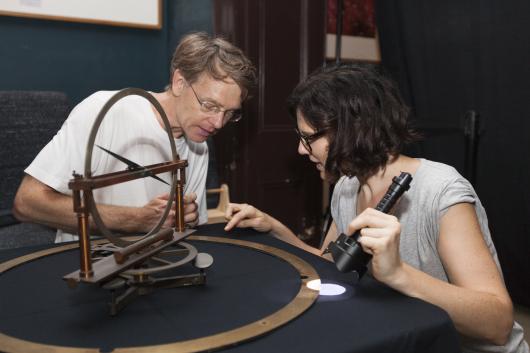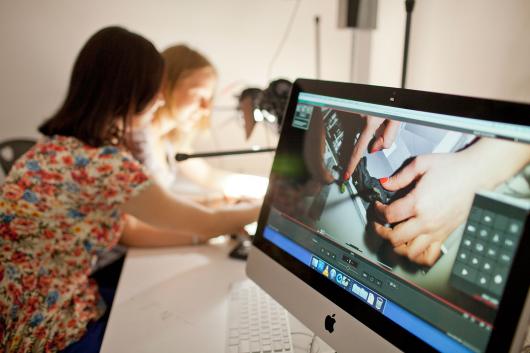Used by students across the Faculty the computer labs have a wide range of design specific software and hardware to facilitate student production.
Bachelor of Design in Visual Communication Bachelor of International Studies (Honours)
Note
This is an exit-only course. There is no direct admission to it. Current UTS students may be able to submit an Internal Course Transfer (Graduating) application to exit with this course. See the Course transfer page for further details.
The Bachelor of Design in Visual Communication Bachelor of International Studies (Honours) is an exit-point for students who have completed the International Honours pathway within the Bachelor of Design in Visual Communication Bachelor of International Studies (C10309).
This distinctive degree explores diverse forms of visual communication across design, culture and media. Visual Communication students acquire in depth understanding of the histories, practices and meanings of the visual world. In turn, obtaining the visual knowledge and skills required to negotiate rapidly changing technology, visual media and culture while becoming skilled in apprehending the unprecedented pace at which visual images, visual technologies and information data are produced.
The combined Bachelor of Design in Visual Communication Bachelor of Arts in International Studies provides students with additional practical skills, in particular those that raise their awareness of the international contexts of design, by providing the opportunity to acquire knowledge and understanding of a language other than English and another culture.
In the fourth year of the combined degree, International Honours students spend an academic year studying in the local language at a university in the country of their major and also complete an honours level research project under the supervision of a relevant UTS academic.
Entry to the International Honours pathway is dependent on students maintaining a credit average (or higher) in both their International Studies and professional degree in their first three years of study, and on the availability of placements in particular majors.
Students immerse themselves in a practice-oriented, studio-based culture, studying a range of interdisciplinary subjects encompassing typography, interaction and image-making. Taught by experts in visual communication, students learn everything from the history and theory of visual culture and technology to producing cutting edge creative work in digital media, photography, editorial design, information visualisation, web design, wayfinding, mobile apps, code, interaction design, machine learning, motion graphics, the internet of things and 3D technologies such as VR/AR and 3D printing. Exploring both traditional and experimental research methods students learn to produce conceptually rigorous and socially responsive work. They graduate with the capacity to work across and between disciplines, to articulate design practices and processes, and to apply them to complex problems. Graduates develop industry experience through the degree's emphasis on addressing real-world issues in collaborative and team-based work.
The international experience enhances career options, making students more marketable to prospective employers.
Course aims
The degree has a hands-on, studio-based culture that is supported by a strong historical and theoretical component. Academics encourage both innovation and experimentation in research and practice to help students make work that is conceptually rigorous and ethically responsive.
Offering a variety of interdisciplinary subjects, graduates are able to move into their professional lives with the diverse knowledge and skills required to work collaboratively and across disciplines. All students work with industry clients on real-world projects and undertake work experience during their degree.
A further two years of study in the international studies component introduces and consolidates learning a language other than English and about another culture.
Course fees
For relevant fee information, please choose from the following:
Local student
All students at UTS pay tuition fees to contribute towards the cost of their studies.
In 2024 all offers made to domestic undergraduate students will be for Commonwealth Supported Places (CSP), which means that the Australian government makes a substantial contribution towards the cost of your education, and you pay the balance through student contributions.
The amount you pay depends on your area of study and the number of credit points (cp) in which you enrol. At UTS 48 credit points is considered to be one Equivalent Full Time Study Load (EFTSL).
The table to the right shows the amount a student can expect to pay for one year of full-time study (1.0 EFTSL).
Students can choose to pay their student contribution upfront, or if eligible, can defer their fees through HECS-HELP.
In addition to tuition fees, students are required to pay a Services and Amenities Fee (SSAF). The purchase of textbooks and other course materials may also result in additional cost.
You can calculate your student contribution as a percentage of the amounts shown on the table. Fee rates are divided into four bands covering broad discipline areas. It is important to note that a particular subject within a course may fall within a different band.
For example, if you are enrolled in a 6-credit point Architecture subject, your contribution would be 6/48 x $9,314 = $1,164.
Student contribution amounts for 2025 commencing students
| 2025 student contribution - Area of Study | Amount for 48 cp |
|---|---|
| Law, Accounting, Administration, Economics, Commerce, Communications and Society and Culture | $16,992 |
| Medicine, Dentistry and Veterinary Science | $13,241 |
| Allied Health, Other Health, Built Environment, Computing, Visual & Performing Arts, Professional Pathway Psychology, Professional Pathway Social Work, Engineering, Surveying, Environmental Studies, Science and Pathology | $9,314 |
| Education, Postgraduate Clinical Psychology, English, Mathematics, Statistics, Nursing or Foreign Languages and Agriculture | $4,627 |
International student
Tuition fees for international undergraduate students can be found using tuition fees search.
Tuition fees must be paid in advance each session and are subject to annual increase. Fees for future year(s) published in fees search, whilst unlikely to change, are estimates only. UTS makes every effort to provide up to date future year(s) fee estimates and to limit any changes, however, UTS reserves the right to vary fees for future year(s) at any time.
For this course, the cost per credit point for 2025 is $974. The total credit points are 240.
All international students should familiarise themselves with the following documents:
- Protocol on refund of fees for international students - contains the refund of fees information for international students.
- Tuition Protection Service - designed to ensure that students receive the tuition they have paid for
In addition to tuition fees, students may be required to pay a Student Services and Amenities Fee (SSAF). Textbooks and other course materials will also result in additional costs.
UTS Alumni save 10%: alumni.uts.edu.au/advantage
For further information on costs related to your study at UTS, visit the international students' fees information page.
Careers
There are many career options in a range of fields for graduates, such as digital media, publication designer, graphic designer, interactive media designer, web designer, branding specialist, art director, motion graphics designer, advertising, illustrator, and exhibition designer. Graduates are also equipped with the skills to become writers, researchers, editors and critics, and to apply design thinking in a non-design industry business.
Course structure
Course structure explained
Students must complete 240 credit points comprising 108 credit points of core subjects, a 24-credit-point of design studies, 12 credit points of electives in visual communication and 96 credit points in International Studies.
International Studies (96 credit points):
- Intercultural Communication (8 credit points)
- International Research Methods (8 credit points)
- Contemporary Society subject (8 credit points)
- Language and Culture subjects (32 credit points)
- International Honours (40 credit points)
Overseas study
International Honours students spend a full year at a relevant partner university where they complete an honours level research project.
Course completion requirements
| Requirement | Credit Points |
|---|---|
| STM91427 Core Subjects (Visual Communication) | 108 |
| STM91882 Design Studies | 18 |
| STM91883 Electives Choice | 18 |
| CBK92058 Country and Language choice (Honours) | 96 |
| Total | 240 |
Additional information
Course duration
The course is offered on a five-year, full-time basis. Students may study this program part time after consultation with the program director. Students spend two sessions of study at a university or other higher education institution in the country of their major.
Inherent requirements
Inherent requirements are academic and non-academic requirements that are essential to the successful completion of a course. For more information about inherent requirements and where prospective and current students can get assistance and advice regarding these, see the UTS Inherent requirements page.
Prospective and current students should carefully read the Inherent Requirements Statement below and consider whether they might experience challenges in successfully completing this course.
UTS will make reasonable adjustments to teaching and learning, assessment, professional experiences, course related work experience and other course activities to facilitate maximum participation by students with disabilities, carer responsibilities, and religious or cultural obligations in their courses.
For course specific information see the Faculty of Design, Architecture and Building Inherent (Essential) Requirements Statement.
For course specific information see the Bachelor of International Studies Diploma in Languages Inherent (Essential) Requirements Statement.
Assumed knowledge
There are no prior language requirements for the international studies program. During their first year of study students complete a language survey to ensure they commence their language and culture study at the appropriate level.
Year 12 adjustment factor scheme
UTS: Handbook
Information for international students
Find out about support services, the Australian education system, accommodation and more to help you get the most out of your study at UTS.
Domestic students
How to apply
This is an exit-only course. Current UTS students wishing to transfer may submit an Internal Course Transfer - Graduating application. To confirm eligibility, check with the UTS Student Centre.
Need more information?
International students
How to apply
This is an exit-only course. Current UTS students wishing to transfer may submit an Internal Course Transfer - Graduating application. To confirm eligibility, check with the UTS Student Centre.


